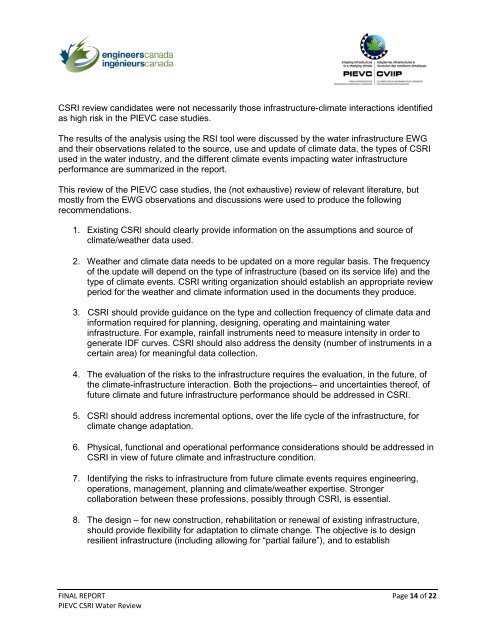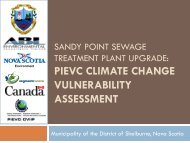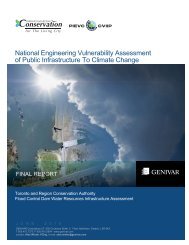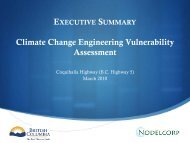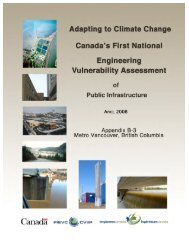Codes, Standards and Related Instruments (CSRI) - Vulnerability ...
Codes, Standards and Related Instruments (CSRI) - Vulnerability ...
Codes, Standards and Related Instruments (CSRI) - Vulnerability ...
Create successful ePaper yourself
Turn your PDF publications into a flip-book with our unique Google optimized e-Paper software.
<strong>CSRI</strong> review c<strong>and</strong>idates were not necessarily those infrastructure-climate interactions identifiedas high risk in the PIEVC case studies.The results of the analysis using the RSI tool were discussed by the water infrastructure EWG<strong>and</strong> their observations related to the source, use <strong>and</strong> update of climate data, the types of <strong>CSRI</strong>used in the water industry, <strong>and</strong> the different climate events impacting water infrastructureperformance are summarized in the report.This review of the PIEVC case studies, the (not exhaustive) review of relevant literature, butmostly from the EWG observations <strong>and</strong> discussions were used to produce the followingrecommendations.1. Existing <strong>CSRI</strong> should clearly provide information on the assumptions <strong>and</strong> source ofclimate/weather data used.2. Weather <strong>and</strong> climate data needs to be updated on a more regular basis. The frequencyof the update will depend on the type of infrastructure (based on its service life) <strong>and</strong> thetype of climate events. <strong>CSRI</strong> writing organization should establish an appropriate reviewperiod for the weather <strong>and</strong> climate information used in the documents they produce.3. <strong>CSRI</strong> should provide guidance on the type <strong>and</strong> collection frequency of climate data <strong>and</strong>information required for planning, designing, operating <strong>and</strong> maintaining waterinfrastructure. For example, rainfall instruments need to measure intensity in order togenerate IDF curves. <strong>CSRI</strong> should also address the density (number of instruments in acertain area) for meaningful data collection.4. The evaluation of the risks to the infrastructure requires the evaluation, in the future, ofthe climate-infrastructure interaction. Both the projections– <strong>and</strong> uncertainties thereof, offuture climate <strong>and</strong> future infrastructure performance should be addressed in <strong>CSRI</strong>.5. <strong>CSRI</strong> should address incremental options, over the life cycle of the infrastructure, forclimate change adaptation.6. Physical, functional <strong>and</strong> operational performance considerations should be addressed in<strong>CSRI</strong> in view of future climate <strong>and</strong> infrastructure condition.7. Identifying the risks to infrastructure from future climate events requires engineering,operations, management, planning <strong>and</strong> climate/weather expertise. Strongercollaboration between these professions, possibly through <strong>CSRI</strong>, is essential.8. The design – for new construction, rehabilitation or renewal of existing infrastructure,should provide flexibility for adaptation to climate change. The objective is to designresilient infrastructure (including allowing for “partial failure”), <strong>and</strong> to establishFINAL REPORT Page 14 of 22PIEVC <strong>CSRI</strong> Water Review


